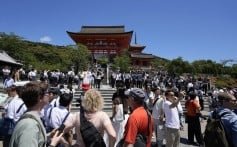
Japan broke the record for monthly visitors in June, according to official data released on Friday, due to the weakening yen that has fueled a tourism boom in the country. The number of foreign visitors for business and leisure reached 3.14 million last month, surpassing the previous monthly record of 3.08 million set in March and up from 3.04 million in May, as reported by the Japan National Tourism Organization (JNTO).
The total arrivals through June reached 17.78 million, also setting a half-year record and on track to surpass the annual record high of 31.9 million in 2019, before the COVID-19 pandemic forced the closure of global borders. Prime Minister Fumio Kishida estimated that spending by visitors would reach 8 trillion yen ($50 billion) this year. He also emphasized the need to prevent “overtourism.” The tourism industry is projected to become Japan’s second-biggest export sector by 2024, after automobiles and ahead of electronic components.
The weakening yen, which has reached a 38-year low against the dollar, has made Japan an attractive destination for overseas travelers. Out of 23 markets tracked by the JNTO, travelers from 18 regions set new records for June arrivals. The weak yen has significantly increased Japan’s appeal, leading to more spontaneous travel plans.
Additionally, there has been a shift in the composition of visitors, with a decrease in the proportion of Chinese travelers compared to 2019. Arrivals from mainland China in June were down 25% from the same month in 2019, according to JNTO data. While increased traveler spending has benefited the economy, concerns about overcrowding and environmental impact have prompted officials to impose measures such as admission fees and hiker limits at tourist hotspots.
The government aims to further develop the tourism sector, with Prime Minister Kishida setting a goal of nearly doubling annual visitors to 60 million and their spending to 15 trillion yen by 2030. He emphasized the importance of promoting tourism to regional areas and implementing measures to prevent overtourism.